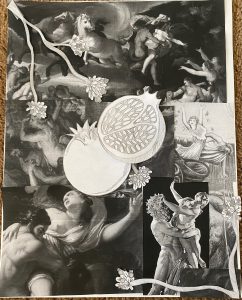40 Redefining the Pomegranate
TW: images of rape
Redefining the Pomegranate by Lauren Ziment
While looking into the afterlife of the poem, I was struck by how the dominant narrative I was finding was one that portrayed the relationship between Persephone and Hades as consensual and often very sexual and romantic. After reading the poem, I had interpreted the relationship in a completely contrary way. The fact that Hades took ownership of Persephone without her consent, raped her, and brought her to the underworld against her own will makes it evident that this was not the sensual, romantic relationship that is being portrayed in pop culture and artistic interpretations. Even when you conduct a basic google search of “Hades and Persephone,” majority of the images that will come up are along with this mainstream, dominant narrative, rather than the poem’s actual telling of a relationship plagued by rape, possession, and lack of agency (specifically Persephone’s lack of agency). Images like the ones I have included below are what dominates the pop culture view of this relationship, rather than portraying the fact that Persephone was required to be with Hades in the underworld after eating a pomegranate, not fully aware of the consequences.

This narrative romanticizes and condones Hades rape and forcible ownership of Persephone, in turn demeaning her own autonomy and agency in Greek mythology. Not only is this narrative extremely harmful, but the symbol of the pomegranate itself and its legacy in Greek mythology is extremely harmful in condoning and perpetuating rape culture. In Greek mythology, the pomegranate has come to be a symbol of many things that can be perceived as positive including: life, rebirth, eternal life, fertility, marriage, abundance/plenty, etc. All of these are recurring words associated with the meaning of the pomegranate and all put the symbol in a positive light. With this interpretation of the significance of the pomegranate, its purpose in the hymn would be as the thing that brought Persephone to Hades and connected them in marriage and in a new beginning of life and love. Obviously, for reasons I mentioned before, this interpretation of the pomegranate contributes to the misinterpretation, in my opinion, of this narrative. Rather, the pomegranate, to me, is a symbol of rape, ownership, and dominance. When eating the pomegranate, many interpretations suggest that Hades tricked Persephone into eating it and/or that she was not aware of the consequences associated with eating the pomegranate. This all suggests that Persephone did not have true agency in the situation and in eating the fruit, thus, to me, the pomegranate represents the very idea that Persephone is bound to the underworld and to Hades against her will.
For my contribution to the afterlife of this poem, I wanted to redefine this symbol. I am by no means an artist, but alas I tried. In my piece, I have collaged together images (which believe me when I say it was upsetting how little of these exist) in which persephone is resisting Hades and is trying to escape as he forcibly takes her. I wanted to empower Persephone’s agency in the situation and her ability to not give consent. At the very center of the collage, I included drawings of the pomegranate, with branches of a pomegranate tree dominating the collage. Through this collage, I hope to contribute my own interpretation of the symbolic meaning of the pomegranate and associate it with the narrative that is too often overlooked in pop culture interpretations of the relationship between Persephone and Hades. Through this piece, I hope to counter the dominant narrative of a romantic union between the two, and instead shed light on the fact that Persephone was taken completely against her will and bound in marriage and to the underworld without the ability to follow her own wishes of being back with her mother for the rest of her life.

